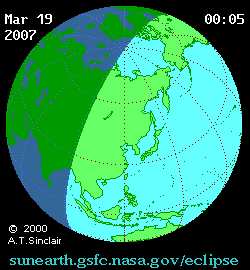| Partial eclipse | |
 From Jaipur, India at sunrise | |
| Gamma | 1.0728 |
|---|---|
| Magnitude | 0.8756 |
| Maximum eclipse | |
| Coordinates | 61°00′N55°30′E / 61°N 55.5°E |
| Times (UTC) | |
| Greatest eclipse | 2:32:57 |
| References | |
| Saros | 149 (20 of 71) |
| Catalog # (SE5000) | 9523 |
A partial solar eclipse occurred at the Moon's ascending node of orbit on Monday, March 19, 2007, [1] [2] [3] with a magnitude of 0.8756. A solar eclipse occurs when the Moon passes between Earth and the Sun, thereby totally or partly obscuring the image of the Sun for a viewer on Earth. A partial solar eclipse occurs in the polar regions of the Earth when the center of the Moon's shadow misses the Earth.
Contents
- Images
- Eclipse timing
- Places experiencing partial eclipse
- Gallery
- Eclipse details
- Eclipse season
- Related eclipses
- Eclipses in 2007
- Metonic
- Tzolkinex
- Half-Saros
- Tritos
- Solar Saros 149
- Inex
- Triad
- Solar eclipses of 2004–2007
- Saros 149
- Metonic series
- Tritos series
- Inex series
- References
This partial eclipse was visible from India at sunrise, across Asia and eastern part of European Russia, and ending near sunset over northern Alaska. The greatest eclipse was on north of Perm Krai, Russia.








































































































